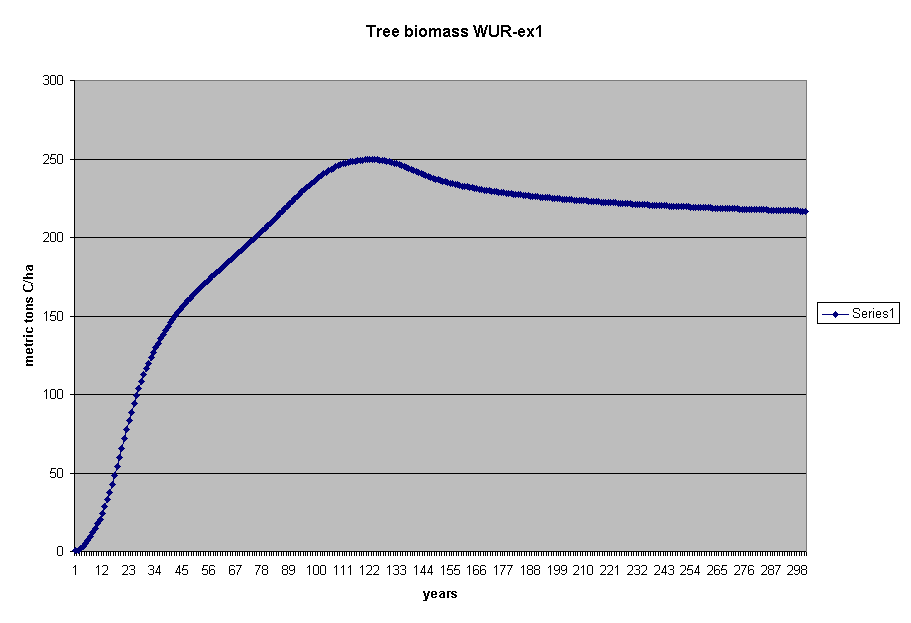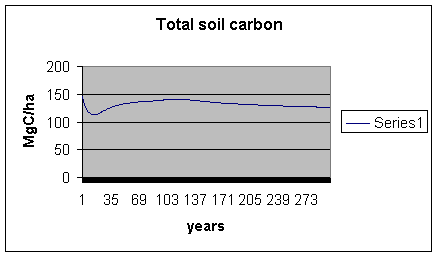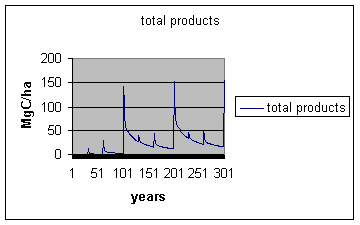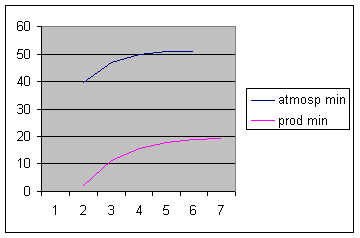This lesson uses a professional forestry model to explore the movement of carbon between the atmosphere, forest and forest products. The model allows the students to change a number of variables within the model to explore different forest management practices. In addition to learning about the carbon cycle the students learn how to mine data. The data in the model is displayed as two tables. The students copy and paste the data into an Excel spreadsheet where they manipulate and graph the information. The model is a free download.
Answers to questions.
Page model1
Ask your teacher if you will be using CO2fix, This is the model made by Wageningen University and Research Center, or the Excel version.
In CO2fix open the model named WUR-ex1. When WUR-ex1 opens you see the carbon stock table. This is the run for the forest plot. Each row is one year.
How many years does this run model the forest?
300 years
What parts of the tree does the model monitor?
What is the total dry mass of the trees when the simulation starts? .64 Mg/ha Mg is a metric ton or a million grams.
What is the total mass of the trees at the end of the simulation?
433.52 Mg/ha
Copy the Biomass dry weight column into an Excel spread. Graph the column to see how the mass changes over time.
 |
The biomass increases rapidly for the first 35 years as the forest starts to grow. Then the biomass increases at a moderate rate until year 100. Next the amount of Biomass levels off and starts to decline about year 120. There is a gradual decline in the biomass for the remainder of the run.
What percentage of the Biomass is carbon? 50%
Find the column that shows the total carbon in the soil. Copy this column to your spreadsheet and graph it.

Which year has the most carbon in the soil? year 0, at the beginning of the experiment.
Explain why the soils carbon dips then increases then decreases again. The carbon is constantly decomposing and changing back into CO2. In the first years the trees are small and produce very few needles and debris. The carbon in the soil is disappearing faster than it is being replaced. As the trees mature they produce more debris and the amount of carbon in the soil increases. When the trees reach maturity their production of needles and debris levels off and starts to decline slightly with increasing age. The soil C level mirrors this gradual decline.
Explore the data on your own to answer these questions.
Which year has the largest amount of carbon in the forest? 121
How much carbon is in the forest this year? 390.29 MgC/ha
Which year is the most carbon being sequestered? Look at the flows chart. Copy the atmosphere increments and losses columns onto a spreadsheet. In a third column calculate the difference by subtracting the losses from the increments. In year 20 the atmosphere lost 6.91 MgC/ha. The forest stored this 6.91 Mg. It is important that the students differentiate between the total carbon stored during a year and the change in carbon during that year.
Which year does the forest start producing more CO2 than it is sequestering? year 122
After the year when the largest amount of carbon is in the forest what is the relationship between the forest and the atmosphere? The atmosphere starts putting more C02 into the atmosphere than it is removing.
Is the forest removing or adding CO2 to the atmosphere? Adding
The trees are getting bigger and older why doesn't the forest contain more CO2? Tree growth slows but doesn't stop. There is more damage to the trees, increasing the litter on the soil, thus increasing the C02 the soil produces. Some trees die and slowly rot to produce more CO2.
Which age range of forest would we need to help balance the CO2 that we are adding to the atmosphere? Young forests. With this kind of tree, Norway Spruce, 6 < forest > 121 can sequester Carbon. Between 12 and 50 years old is the best.
What implications would this have on our national forest policy if we want the forests to help deal with our CO2 responsibilities. We should consider harvesting some of our forests to keep them young. We haven't explored the effect of harvesting forests on the carbon balance, so we can't draw conclusions yet but we should look into it.
What are the product values in the model? 0 (all 0) this forest isn't harvested. It is managed like a wilderness area.
Lumber is removed from most of our forests. This model allows us to simulate harvesting of products from the forest.
The authors of the model suggest you practice thinning your forest by following these directions.
The green text is the suggestions of the model authors.
Open "WUR-ex2.co2" you will start to manage the forest and produce wood products Go to the biomass parameterisation module, and choose the "thinning harvest" tag
Parameterise two thinnings (year 30 and 60) and one final felling at age 100. Fraction removed is resp 0.25, 0.25, and 1.
Allocate of first thinning, .1 to logwood, and .7 to pulp-pap
Allocate of second thinning, .3 to logwood, and .6 to pulp-pap
Allocate of final felling, .7 to logwood, and .2 to pulp-pap. Leave the rest of the cells as they are, i.e. all branches are allocated to slash.
Now choose "Apply" and "OK"
Go to "products parameterisation module". This has now been parameterised for you. Try to get an idea what has been inserted for products.
What fraction of products in long term use will be recycled at the end of their life?
What fraction of recycled products in long term use, will go to products with a medium term use?
Now choose "Apply" and "OK"
Under the icon View options" choose the "products". Analyse what you see.
Go back to the "view carbon stocks table", and copy the column with the total products carbon stock into an excel sheet.
Graph this column. Explain the curve i.e. why does it spike up and then curve back down again over and over again? When the forest is harvested the carbon is removed to make paper or lumber. Over time the paper etc. is used and discarded to return to C02 in the air. Some of the product is recycled. Over time less is available to be recycled and also to change back to C02
Is there an overall trend? Some of the product remains from the previous harvest so the subsequent product levels are larger than the initial ones.

On the stocks table copy the column with total atmosphere C. Graph the atmospheric and products C together. What patterns do you see? Both are variable so how can you find a pattern or trend that they share? The products increase at the same time the atmospheric C02 increases and they decrease together. Stated an other way, as the products increase the sequestered C02 decreases. Sequestered C02 and products are approximate mirror images of each other.The atmospheric levels rebound from the rush of a harvest more gradually.

Both have minimum values at 100 year periods. If you graph these minimum values you will see a relationship.

What should we conclude about the forests ability to permanently sequester our carbon?
It may be able to hold the carbon but the rate on additional sequestration declines with time.
If you are using the downloaded model you can ask your students to change the run from 300 years to 500 or 600 years to see if the trend continues.
Suggest ways to change our forest management strategy or product recycling policy. I.E. should we harvest on a different schedule, harvest part of the top of the trees into pulp, have a recycling campaign? You need to justify the practicality of your policy changes.
Many different options are available to the students. One of the most effective changes is to change the final product values. Click on the chair. Change the Energy values to .1 instead of .4, .7, and .6. That changes the final disposition of part of the products from burning for energy to landfill.
You may find it useful to open the student version of:
Forests, Mining Carbon from the Air
in a separate window. This will allow you to toggle between the teacher discussions and the student lesson.


